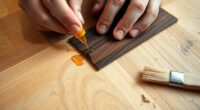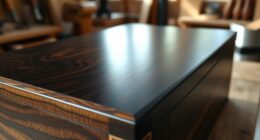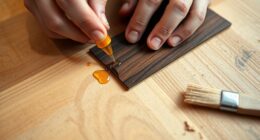To seal and protect veneer, apply a clear finish like polyurethane, acrylic, or oil-based sealants to enhance its natural beauty and prevent damage from moisture, UV rays, and wear. Start with a clean, smooth surface and apply several thin coats, sanding lightly between layers for best adhesion. Choosing the right finish type guarantees vibrant grain and color preservation while providing a durable barrier. Continue exploring, and you’ll discover how to achieve stunning, long-lasting results.
Key Takeaways
- Choose the appropriate clear finish (polyurethane, water-based, or oil-based) based on desired appearance and durability.
- Ensure the veneer surface is clean, smooth, and free of dust before applying the finish.
- Apply multiple thin coats with light sanding between layers for even coverage and better protection.
- Use proper techniques to prevent bubbles, drips, and uneven application for optimal sealing.
- Regularly maintain the finish to preserve the veneer’s natural appearance and prevent fading or damage.

Veneer finishes are a popular choice for enhancing the appearance of wood surfaces, offering a sleek and natural look without the high cost of solid wood. When you apply a clear finish, you’re not just protecting the veneer—you’re also highlighting its inherent beauty. One key benefit of using clear finishes is their ability to improve grain enhancement, bringing out the intricate patterns and textures in the veneer. Without a protective layer, the grain can appear dull or washed out over time, especially with exposure to light or air. A good clear finish deepens the natural grain, giving your piece a richer, more vibrant look that draws attention to the wood’s unique character.
Color stabilization is another essential aspect when sealing veneer. Wood surfaces, especially veneers, can be sensitive to environmental changes; fluctuations in humidity and temperature often cause the color to shift or fade. Applying a clear finish helps lock in the original hue, preventing discoloration or uneven fading. It creates a barrier that minimizes the effects of UV rays and moisture, maintaining your veneer’s color consistency over years of use. This stabilization ensures your furniture or panel retains its intended aesthetic without frequent touch-ups or refinishing.
Choosing the right clear finish is critical for achieving ideal results. For instance, a polyurethane or acrylic sealant offers excellent durability and resistance to scratches, spills, and general wear. These finishes also enhance grain and stabilize color effectively. If you prefer a more natural or matte look, water-based finishes are a good option—they dry quickly and tend to preserve the natural appearance of the veneer without adding significant gloss. On the other hand, oil-based finishes penetrate deeper into the veneer, providing a more substantial layer of protection and a warm, rich finish that accentuates grain enhancement.
Applying a clear finish requires careful preparation. You should guarantee the surface is clean, smooth, and free of dust or oils. Light sanding between coats can further improve adhesion and smoothness. Multiple thin coats often deliver better results than a single thick application, allowing for even coverage and more effective sealing. Remember, patience is key—allow each coat to dry thoroughly before applying the next to avoid bubbles or uneven surfaces.
Frequently Asked Questions
How Long Does a Clear Finish Typically Last on Veneer?
A clear finish on veneer usually lasts around 2 to 5 years, depending on finish durability and how often the surface is used. You should expect some aging and wear over time, especially in high-traffic areas. Regular maintenance, like cleaning and reapplying a protective coat, can extend the life of the finish and keep your veneer looking fresh longer. Proper application initially also plays a vital role.
Can Clear Finishes Be Applied Over Painted Veneer?
Applying clear finishes over painted veneer is like layering a protective coat on a delicate painting—you just need the right approach. You should verify compatibility concerns are addressed, as some finishes may not adhere well or could damage the paint beneath. Use proper application techniques like light sanding and thin coats to prevent issues. Always test on a small area first to guarantee a smooth, durable finish without compromising your painted veneer’s appearance.
Is There a Difference Between Indoor and Outdoor Veneer Finishes?
Yes, there’s a difference between indoor and outdoor veneer finishes. You’ll want an indoor finish that offers good indoor durability, protecting against scratches and wear inside your home. For outdoor veneer, you need a finish designed for outdoor protection, resisting UV rays, moisture, and temperature changes. Using the right finish guarantees your veneer stays beautiful and protected, whether it’s inside or outside. Always choose products specifically formulated for your application’s environment.
How Do I Fix a Cloudy or Uneven Finish on Veneer?
Fixing a flaky, foggy finish starts with thorough surface preparation and proper finishing techniques. First, gently sand the veneer with fine-grit paper to remove the uneven finish. Then, clean off dust and residue before applying a fresh, even coat of clear finish. Use smooth, steady strokes to avoid streaks and blotches. Patience and precision guarantee a polished, pristine veneer surface, leaving it looking flawless and fabulous.
Are There Eco-Friendly Clear Finish Options for Veneer?
Yes, you can choose eco-friendly clear finishes for veneer, like non-toxic coatings and biodegradable sealants. These options are safer for you and the environment, avoiding harmful chemicals found in traditional finishes. Look for labels that specify biodegradability or non-toxicity, and apply them carefully to protect your veneer while minimizing environmental impact. These finishes provide a clear, protective layer without compromising your health or the planet.
Conclusion
By sealing and protecting your veneer with clear finishes, you guarantee its beauty lasts for years. Many believe that applying a finish is only about appearance, but it also guards against moisture, scratches, and fading. When you choose the right product and apply it properly, you truly enhance and preserve your veneer’s natural charm. So, trust the process, enjoy your work, and take pride in creating a durable, stunning piece that stands the test of time.









